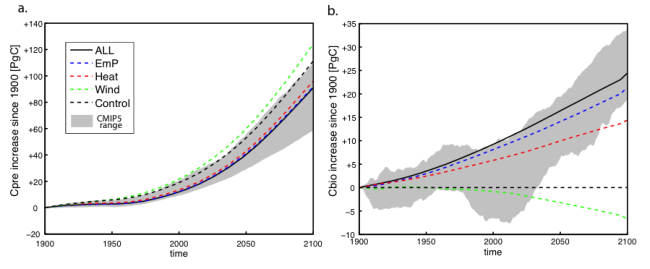Southern Ocean carbon storage in a warming climate
The Southern Ocean plays a key role in mitigating the anthropogenic greenhouse emissions by contributing approximately 40% of the global oceanic carbon sink.

Recent work by Ito et al. investigates the future evolution of Southern Ocean carbon storage under a climate warming scenario - the Representative Concentration Pathway 8.5 or RCP8.5 scenario - by analyzing a subset of Coupled Model Intercomparison Project Phase 5 (CMIP5) models, and the mechanisms controlling such progression by performing a suite of sensitivity experiments.
CMIP5 integrations predict that the inventory of biologically sequestered carbon south of 40°S will increase relative to the preindustrial condition about 18–34 PgC by 2100. To put this figure into the context, the global ocean absorbs approximately 2 PgC of anthropogenic carbon each year in recent decades. Thus it is equivalent of 9–17 years worth of cumulative oceanic carbon uptake at the current uptake rate. Sensitivity experiments with an ocean circulation and biogeochemistry model illustrate the processes behind such increase exploring the relative role of freshwater, thermal, and wind forcing and their combination. Firstly, the intensification and poleward shift of the westerly wind causes a strengthening of the upper overturning circulation. This in turn leads to an increased uptake of anthropogenic CO2 and also to the release of biologically regenerated carbon to the atmosphere. Secondly, the freshening of Antarctic surface water induces a slowdown of the lower overturning circulation, leading to an increase of the biological carbon storage in the Southern Ocean. The net effect of these processes taken together is a sustained growth of the carbon storage in the Southern Ocean, notwithstanding a weaker global ocean carbon uptake predicted by all models in a warming climate.
Sustained growth of the Southern Ocean carbon storage in a warming climate (Geophysical Research Letters)
1 Georgia Institute of Technology
2 University of Washington
3 National Center for Atmospheric Research
Topics
- Southern Ocean
- Carbon
- Climate Change
